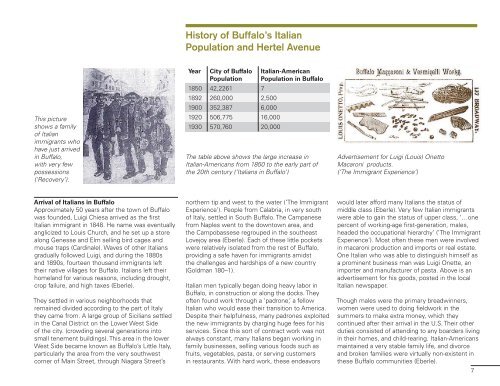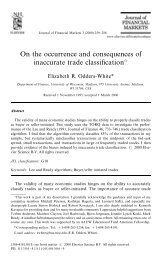Hertel Avenue - Acsu Buffalo - University at Buffalo
Hertel Avenue - Acsu Buffalo - University at Buffalo
Hertel Avenue - Acsu Buffalo - University at Buffalo
Create successful ePaper yourself
Turn your PDF publications into a flip-book with our unique Google optimized e-Paper software.
This picture<br />
shows a family<br />
of Italian<br />
immigrants who<br />
have just arrived<br />
in <strong>Buffalo</strong>,<br />
with very few<br />
possessions<br />
(‘Recovery’).<br />
Arrival of Italians in <strong>Buffalo</strong><br />
Approxim<strong>at</strong>ely 50 years after the town of <strong>Buffalo</strong><br />
was founded, Luigi Chiesa arrived as the first<br />
Italian immigrant in 1848. He name was eventually<br />
anglicized to Louis Church, and he set up a store<br />
along Genesse and Elm selling bird cages and<br />
mouse traps (Cardinale). Waves of other Italians<br />
gradually followed Luigi, and during the 1880s<br />
and 1890s, fourteen thousand immigrants left<br />
their n<strong>at</strong>ive villages for <strong>Buffalo</strong>. Italians left their<br />
homeland for various reasons, including drought,<br />
crop failure, and high taxes (Eberle).<br />
They settled in various neighborhoods th<strong>at</strong><br />
remained divided according to the part of Italy<br />
they came from. A large group of Sicilians settled<br />
in the Canal District on the Lower West Side<br />
of the city. (crowding several gener<strong>at</strong>ions into<br />
small tenement buildings). This area in the lower<br />
West Side became known as <strong>Buffalo</strong>’s Little Italy,<br />
particularly the area from the very southwest<br />
corner of Main Street, through Niagara Street’s<br />
History of <strong>Buffalo</strong>’s Italian<br />
Popul<strong>at</strong>ion and <strong>Hertel</strong> <strong>Avenue</strong><br />
Year City of <strong>Buffalo</strong><br />
Popul<strong>at</strong>ion<br />
1850 42,2261 7<br />
1892 260,000 2,500<br />
1900 352,387 6,000<br />
1920 506,775 16,000<br />
1930 570,760 20,000<br />
Italian-American<br />
Popul<strong>at</strong>ion in <strong>Buffalo</strong><br />
The table above shows the large increase in<br />
Italian-Americans from 1850 to the early part of<br />
the 20th century (‘Italians in <strong>Buffalo</strong>’)<br />
northern tip and west to the w<strong>at</strong>er (‘The Immigrant<br />
Experience’). People from Calabria, in very south<br />
of Italy, settled in South <strong>Buffalo</strong>. The Campanese<br />
from Naples went to the downtown area, and<br />
the Campobassese regrouped in the southeast<br />
Lovejoy area (Eberle). Each of these little pockets<br />
were rel<strong>at</strong>ively isol<strong>at</strong>ed from the rest of <strong>Buffalo</strong>,<br />
providing a safe haven for immigrants amidst<br />
the challenges and hardships of a new country<br />
(Goldman 180–1).<br />
Italian men typically began doing heavy labor in<br />
<strong>Buffalo</strong>, in construction or along the docks. They<br />
often found work through a ‘padrone,’ a fellow<br />
Italian who would ease their transition to America.<br />
Despite their helpfulness, many padrones exploited<br />
the new immigrants by charging huge fees for his<br />
services. Since this sort of contract work was not<br />
always constant, many Italians began working in<br />
family businesses, selling various foods such as<br />
fruits, vegetables, pasta, or serving customers<br />
in restaurants. With hard work, these endeavors<br />
Advertisement for Luigi (Louis) Onetto<br />
Macaroni products.<br />
(‘The Immigrant Experience’)<br />
would l<strong>at</strong>er afford many Italians the st<strong>at</strong>us of<br />
middle class (Eberle). Very few Italian immigrants<br />
were able to gain the st<strong>at</strong>us of upper class, ‘…one<br />
percent of working-age first-gener<strong>at</strong>ion, males,<br />
headed the occup<strong>at</strong>ional hierarchy’ (‘The Immigrant<br />
Experience’). Most often these men were involved<br />
in macaroni production and imports or real est<strong>at</strong>e.<br />
One Italian who was able to distinguish himself as<br />
a prominent business man was Luigi Onette, an<br />
importer and manufacturer of pasta. Above is an<br />
advertisement for his goods, posted in the local<br />
Italian newspaper.<br />
Though males were the primary breadwinners,<br />
women were used to doing fieldwork in the<br />
summers to make extra money, which they<br />
continued after their arrival in the U.S. Their other<br />
duties consisted of <strong>at</strong>tending to any boarders living<br />
in their homes, and child-rearing. Italian-Americans<br />
maintained a very stable family life, and divorce<br />
and broken families were virtually non-existent in<br />
these <strong>Buffalo</strong> communities (Eberle).<br />
7
















